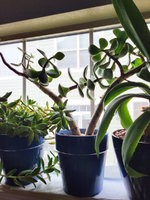ShadyStump
Imperial Masterpiece
Your hibiscus will be ok with the humidity, but not the others. Brightest window you have. You'll hear people say they don't make good bonsai, but you can't beat waking up to those flowers on a winter morning, so go for broke. I've got a few of them nowadays.
Portulacaria Afra are technically succulents, so treat them like a cactus almost. Dry, hot air, water thoroughly, but rarely. You can actually just watch the foliage, and when you see it start wrinkle ever so slightly, that's when you water. And those things are impervious to sunlight. Come summer they'll be the one thing you won't have to worry about leaving outside and forgetting for a week. They also are about as easy to start from cuttings as anything in the world, so whenever you trim, or accidentally break it, just stick in some soil, water only once, then wait for it to grow into a new plant.
Portulacaria Afra are technically succulents, so treat them like a cactus almost. Dry, hot air, water thoroughly, but rarely. You can actually just watch the foliage, and when you see it start wrinkle ever so slightly, that's when you water. And those things are impervious to sunlight. Come summer they'll be the one thing you won't have to worry about leaving outside and forgetting for a week. They also are about as easy to start from cuttings as anything in the world, so whenever you trim, or accidentally break it, just stick in some soil, water only once, then wait for it to grow into a new plant.




